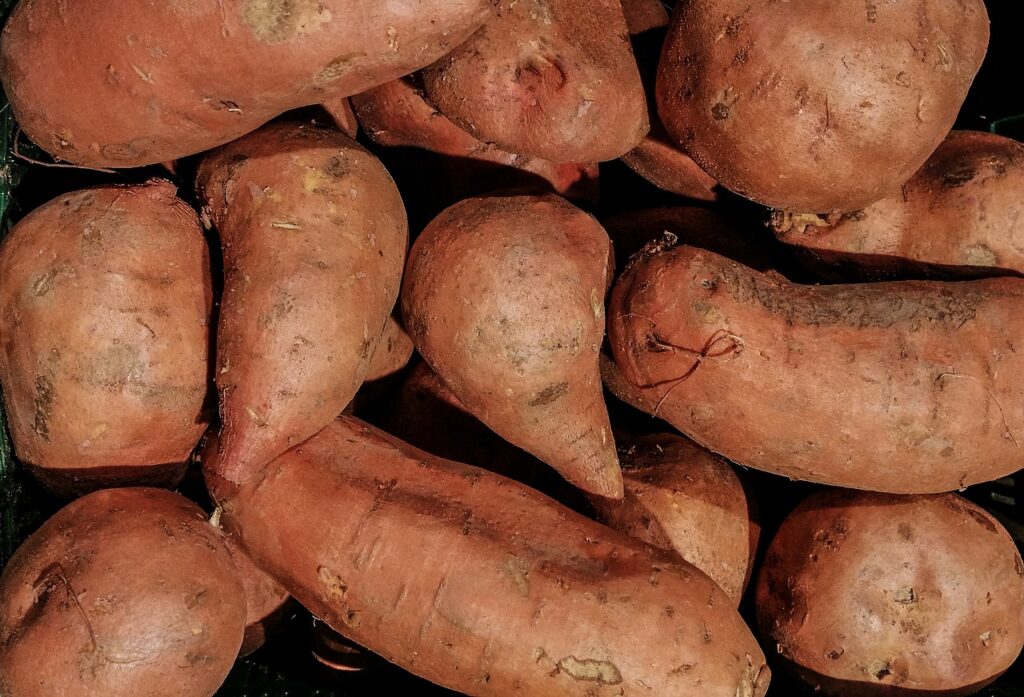We use cookies to make your experience better. To comply with the new e-Privacy directive, we need to ask for your consent to set the cookies. Learn more.
Unusual Tubers
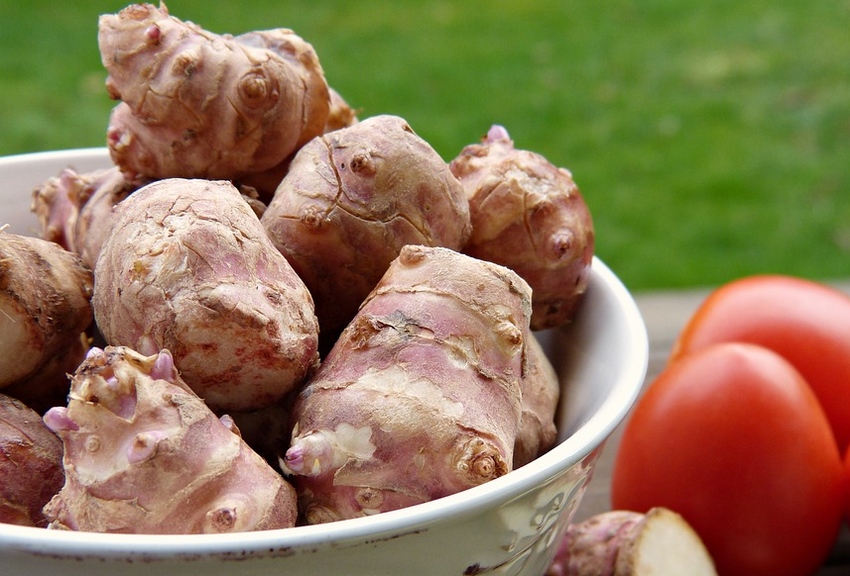
Unusual Tubers
Looking for something new and interesting to grow this season? Take a look at our range of unusual tubers!
Organic Yacon Smallanthus sonchifolius
A perennial tuber from South America known for it's crisp texture and sweet flavour. Underground, yacon grows a bit like a dahlia - with a small clump of knobbly growing tips/rhizomes and large storage tubers. The large edible tubers act as the energy storage facility for the plant, and the smaller propagation roots (resembling small Jerusalem artichokes) are the seeds for the following year's growth.
Growing
- Yacon thrives in temperate climates, making it suitable for cultivation in Ireland. Plant it in well-drained soil with a slightly acidic to neutral pH. Ensure good sunlight exposure for optimal growth.
- Yacon is typically grown from rhizomes or tubers. Plant these in early spring, once risk of frost has passed. Space them about 60-90cm apart. Ensure the soil is consistently moist during the growing season.
- Regular watering is crucial, especially during dry spells. Mulching can help retain moisture and control weeds. Yacon plants can reach heights of 1.5 to 2 metres.
- When harvesting, separate the reddish rhizomes from the tubers and wash off any soil, taking care not to break the skin. These rhizomes can be used to propagate (for next years plants). Keep them out of the sun and covered with slightly damp sand or sawdust to stop them drying out and stored in a dark, dry place.
- In early spring plant the rhizomes into large pots and wait for shoots to start growing. When the shoots have formed, split the rhizomes into individual shoots with their tubers attached and plant into smaller pots.
Harvesting & Storing
- Harvest yacon tubers when the plants die back. They are safe to leave in the ground but best to lift them if a heavy frost is coming. Carefully dig around the plant, being cautious not to damage the tubers. Lift the entire plant, and shake off excess soil. Gently snap the tubers off the crown.
- Yacon tubers benefit from a short curing period. Allow them to air-dry for a week in a shaded, well-ventilated area. This enhances their sweetness and prolongs storage life.
- Store cured yacon tubers in a cool, dark place. They can be kept for several months if stored properly. Ensure good air circulation to prevent mould or rot.
Eating
- Yacon has a crunchy texture, slightly reminiscent of water chestnuts, and a mild sweet flavour, so it's delicious simply peeled, sliced and eaten as a snack.
- It has a tendency to brown so make sure to prepare it just before serving or sprinkle it with some lemon juice.
- While yacon is commonly eaten raw, it can also be cooked. Baking or stir-frying brings out its sweetness, making it a tasty side dish or even a dessert ingredient.
- The tubers and leaves contain high levels of inulin, a form of sugar humans cannot easily break down, making it low in calories. Inulin also aids digestion and promotes the growth of beneficial bacteria in the intestine. Yacon is an ideal food for some diabetics.
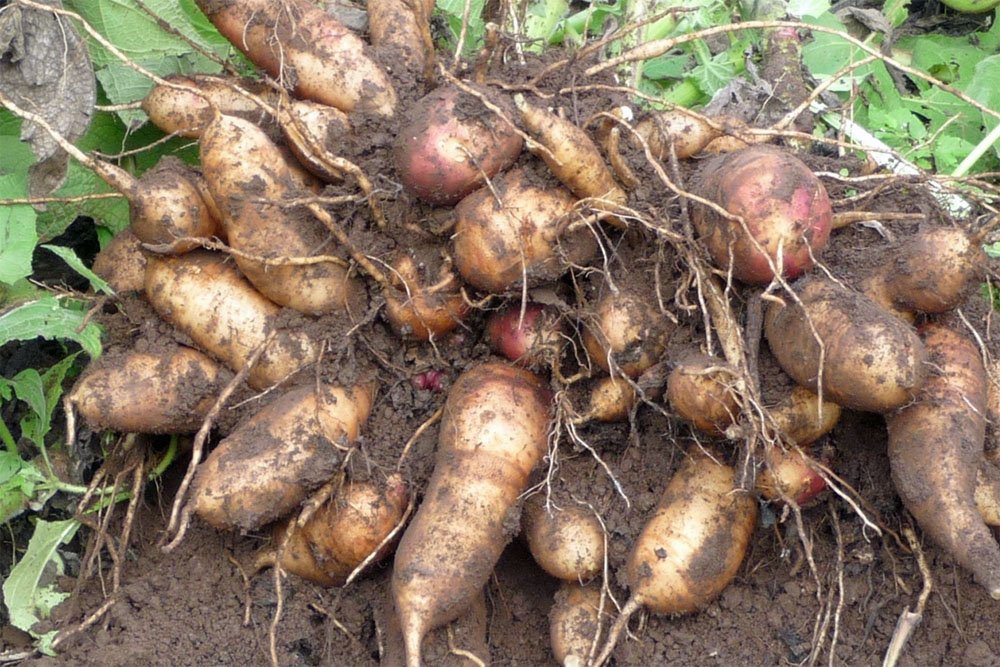
Organic Jerusalem Artichoke Helianthus tuberosus
Not hailing from Jerusalem, nor an artichoke, but a species of sunflower which produces masses of edible tubers. Jerusalem artichokes originated in North America and were introduced to Europe by colonists. Fond of the climate here, they grew prolifically and have been used since for both animal and human fodder as well as to ferment into alcohol.
Growing
Jerusalem artichokes are very easy to grow but some things are worth considering -
- They are large plants which can be between 1.5-3m high so be careful not to put them where they will shade out your other crops.
- From April, plant into well-prepared soil at a depth of 10-15cm with tubers spaced 30cm apart. Row spacing 1m.
- When stems are around 30cm tall, draw soil around them to a depth of 20cm to help stabilise plants as they grow.
- You can cut back stems (including flowerheads) to around 1.5m in midsummer so plants won’t be rocked by the wind, thus avoiding the need for staking.
- When foliage starts to turn yellow in autumn, prune to leave 10cm stumps above ground level. Place the prunings over plants to keep the soil warm and aid lifting of tubers in frosty weather.
- Can be left in the soil and harvested as needed. If you have heavy wet soil it is best to lift and store them.
Harvesting & Storing
- Harvest the tubers as required with a garden fork from late autumn into winter.
- Jerusalem artichokes are persistent, so if you don’t want them coming back the following year, make sure you remove every last one - tubers left in the ground will regrow into a large plant the following spring.
- Harvested early they taste earthy. If left in the ground longer and exposed to the cold winter months they become sweeter.
Eating
- You can cook Jerusalem artichokes peeled or unpeeled. Scrub them with a stiff brush just before you cook them. Sorting your tubers by size will simplify preparation.
- Medium-sized Jerusalem artichokes that have numerous bumps and knobs can be boiled whole in their skins and then mashed and sieved to form the basis for Jerusalem artichoke soup, which many say is the best way to eat the veggie.
- Rather than struggling to peel small, knobby tubers, scrub them well and then roast them with a little olive oil and sea salt. After they’ve cooled, eat them as finger food by squeezing the soft middle into your mouth - a North American food practice that dates back more than 1,000 years!
- Jerusalem artichokes get their sweetness from a unique sugar called inulin, which the body metabolizes much more slowly than it does other sugars. This makes the veggie a preferred food for diabetics, and for anyone who wants to avoid eating simple sugars and starches.
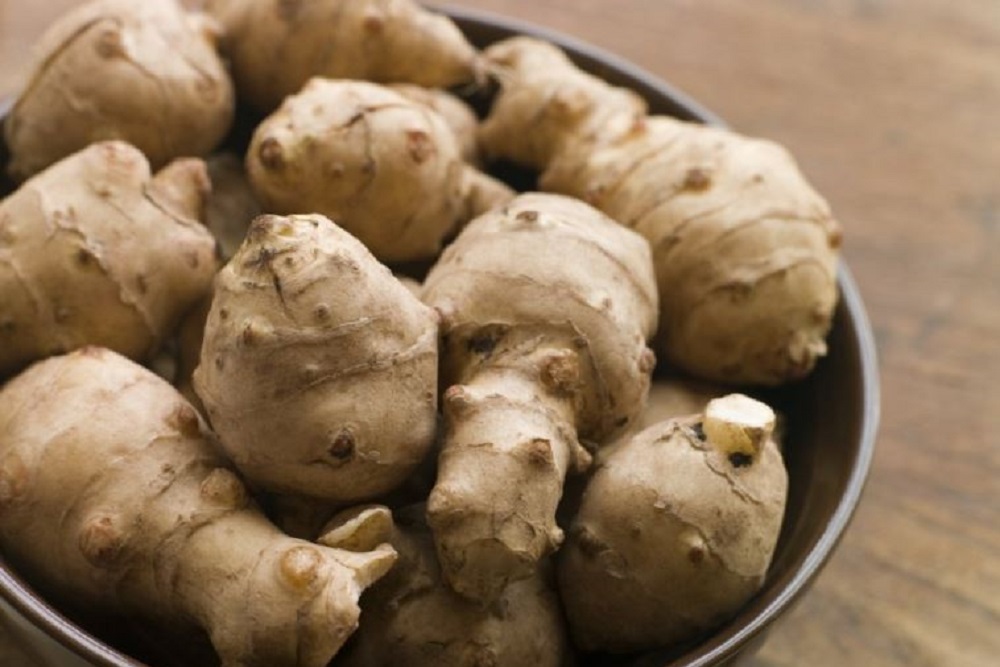
Oca Oxalis tuberosa
A perennial herbaceous plant that overwinters as underground stem tubers. Oca is an ancient Incan crop which is grown widely in the Andes and is now becoming more known around the world. Oca are very easy to grow in Ireland and are happy in the very different low altitude environment here. The leaves, which are also edible, are similar to our native wood sorrel which they are related to. Both are of the Oxalis family named after the oxalic acid which gives them their sharp citrusy flavour.
Growing
- Oca can be grown similarly to potatoes, though they are not susceptible to blight.
- Tubers can be planted out in mid April or after the last frost in your area.
- They can also be started off in pots.
- They can be planted closer than potatoes with 30cm between plants and around 40cm between rows.
- Oca does not need to follow a strict rotation as it has no specific pests or diseases.
- Plants can be mulched or earthed up during the summer to keep moisture in the soil.
- Water in dry spells or yields and tuber size will be affected.
- The tubers begin to form only after the days are shorter than 9 hours so a long autumn season is important for good yields.
- Don't harvest before frost has killed off the leaves and then wait for a couple of weeks.
- Can be stored for several months in boxes of sand or soil in a cool frost-free shed.
Harvesting & Storing
- Harvest late Autumn.
- Ocas may be stored for several months in boxes of sand or soil in a cool frost-free shed.
- Each planted tuber will yield up to 15 good tubers and quite a lot of small ones in the autumn. You should save the best ones for replanting the following year.
- Oxalates, concentrated in the skin of the tuber, are reduced if the harvested tubers are exposed to sunlight (tubers do not go green like potatoes). This process also sweetens the taste.
Eating
- Oca tubers can be eaten both raw and cooked. They are easy to clean due to their smooth and waxy skins.
- When eaten raw they have a slight lemony flavour and a similiar texture to a carrot. You can slice them up add some oil, salt, lemon and pepper.
- When cooked, the tubers develop a more nutty flavour. They can be fried, boiled, steamed, deep fried or roasted. Roasted like potatoes they are quite delicious.
- The leaves are also edible and taste similiar to to Wood Sorrel.
- Good source of carbohydrates, phosphorus and iron.
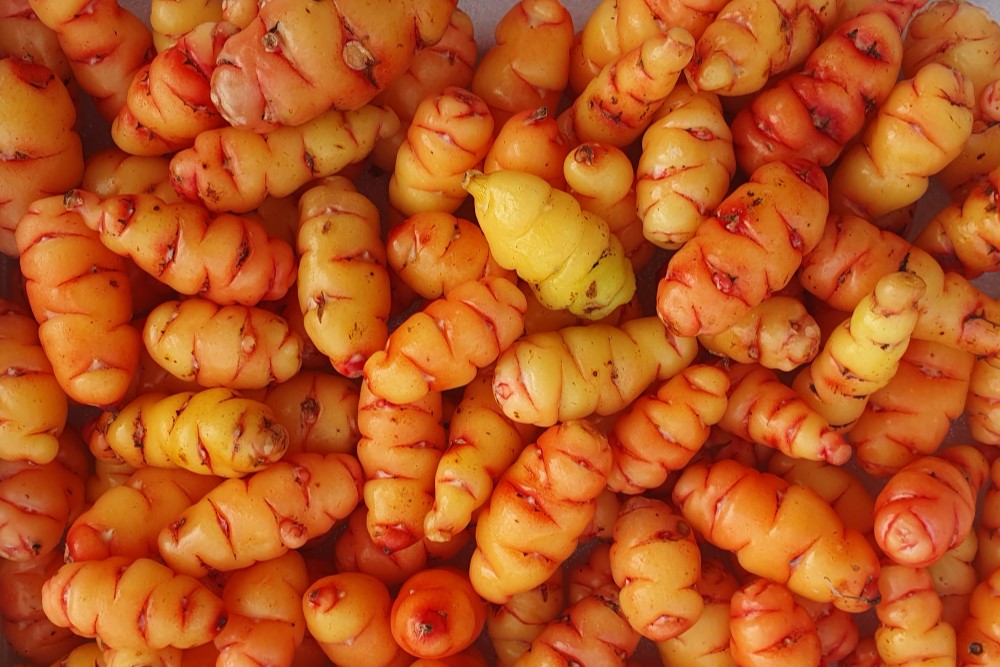
Horseradish Armoracia rusticana
A perennial plant of the Brassica family well known for it's pungent root which is used as a condiment. Horseradish forms a large leafy clump that looks more like a like a dock than a member of the brassica family. It goes dormant over winter and and will re-sprout from the roots in Spring.
Growing
- Grows best in loose soil, free of rocks or in big deep pots.
- Plant the root pieces in Spring at a 45 degree angle with the highest part a few centimeters below the soil level.
- You can feed the plants with a general fertiliser to help them along but they are relatively undemanding.
- Can be harvested in late Autumn when the foliage dies back.
- It will grow back from any pieces of root left behind.
Harvesting & Storing
- Harvest horseradish roots in the fall or early spring for the best flavor.
- Dig around the plant and lift the roots, being mindful of their spreading nature.
- Clean the roots thoroughly, and they are ready for use.
- Horseradish roots can be stored for an extended period. Trim the tops and store them in a cool, dark place.
Eating
- Horseradish is best known for its use as a condiment. Grate the root and mix it with vinegar to create the classic sauce.
- The pungent flavor adds a kick to various dishes, from roast beef to sandwiches.
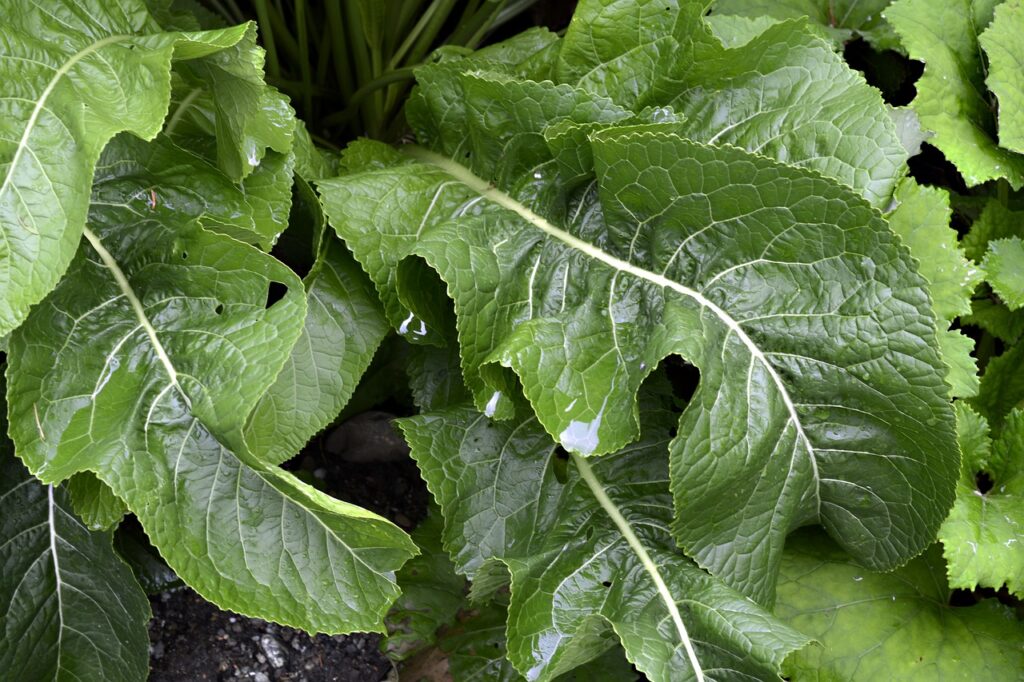
Sweet Potato Ipomoea batatas
Despite its name the sweet potato is not a potato at all, but a member of the Ipomoea family (Morning Glory). They are vigorous climbing plants, with vines reaching 1.5m in length, and have beautiful heart-shaped leaves. Sweet potatoes are started from cuttings (known as slips) in Spring.
Growing
- Sweet potato plants are not hardy so you will need to grow them on in warm, frost free conditions. Best grown in a polytunnel, but they can be grown outside in a very sheltered spot – in which case you will have to harden them off first.
- Pot on into 9cm pots as soon as possible and transplant into their final position when the plants are a good size.
- Plant 45cms apart with 1m between rows.
- Sweet potatoes develop trailing or climbing stems, which can extend to lengths of 1.5 meters. You can grow them vertically using a support to conserve ground space, or you can allow them to sprawl.
- Sweet potato plants require fertile, free draining soil – and they prefer acid or neutral soils.
Harvesting & Storing
- Tubers take four to five months to mature and are best lifted once the leaves turn yellow and die back.
- Lift carefully to avoid bruising.
- Sweet potatoes can be used soon after harvesting, but they will store well for several months if the skins are cured properly. Lay them out in the sun for a few hours immediately after harvesting and then move them to a warm, humid place for 10 days - a greenhouse is ideal. Once the skins have cured they can be stored in cooler conditions provided that they are kept dry.
- Sweet potatoes freeze well if they are blanched or boiled beforehand.
Eating
- Tubers have a sweet, earthy nutty flavour.
- Sweet potatoes are incredibly versatile in the kitchen. Enjoy them roasted, baked, mashed, or in soups and stews.
- Their natural sweetness makes them a popular choice for both sweet and savoury dishes.
- The leaves and tips of young shoots can be cooked as a spinach substitute.
